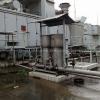|
|
Water Treatment Plant Design
#1

Posted 26 September 2012 - 09:13 AM
I have been given a project to improve the waste water from our phosphoric acid plant. Currently the water is discharged onto gypsum dams and the reclaimed water reused in the process.
If it is economically sensible, the water should be pure enough to discharge back into the environment as the waste water produced is becoming too much for the gypsum dams to handle.
Current specs of the water:
pH very low, 1-2
TDS count >25000 mg/L
the dissolved solids is mainly sulphate, chloride and sodium. Fluoride, calcium, phosphate, iron and copper are also present to a lesser extent.
What I would like to know is how to find the correct combination of treatments for this water. I've read about reverse osmosis and ion exchange, I've also done some tests to see how slaked lime improves the pH and TDS count. But I have no experience in this matter, I would like for someone to give me advice please.
Am I correct in thinking I would have to neutralize the water, coagulate/flocculate the lime sludge, and then proceed with ion exchange/ reverse osmosis? Would a system like this be able to treat 2400 m3/day?
Thank you
Rommie
#2

Posted 26 September 2012 - 03:54 PM
#3

Posted 26 September 2012 - 10:31 PM
Edited by S.Chittibabu, 26 September 2012 - 10:34 PM.
#4

Posted 27 September 2012 - 01:44 AM
I did a quick test in the lab. I added a 1 M solution of slaked lime to the water in a 1:1 volume ratio.
The pH increased to 5-6 and the TDS, after one hour of settling without a flocculant, decreased from 11 ppt to 1.54 ppt!
This is almost within spec for our process water regulations. For now we would be satisfied if we could just get all the wastewater to process water standard (<1420 ppm TDS and pH 6-8) it would be great if we could achieve that with just lime neutralization followed by flocculation/coagulation. Later we would consider environmental discharge, I think RO would be necessary then. It seems RO cannot handle very high TDS counts? I havent found a specific one that can handle TDS>1000 ppm.
Regards
Rommie
#5

Posted 27 September 2012 - 01:50 AM
Talk to the floculants vendor , they should be able to perform jare tests and give you advice . Personnaly I don't think RO will do the job and the technology is expensive (correct me if I'm wrong) , most probably as stated you need to perform physical separation with floculant meaning decantation /clarification then filtration ( centrifugation or filter press ) .
Hope this helps
Breizh
Edited by breizh, 27 September 2012 - 01:51 AM.
#6

Posted 12 October 2012 - 02:42 PM
- Agreed, reverse osmosis units would be horribly expensive to maintain in this application.
- Most of the total dissolved solids (TDS) will be removed via pH adjustment (formation of insoluble salts, which takes the ions to a less soluble form). So, in Rommie's area, whatever the most cost effective source of basic calcium will do the trick I think.
- Rommie will definitely need a clarifier or settling lagoon. I would have to know more about his facility before I specifically recommended a decanting process
- CAUTION: If this is in the US, there are hard processes that one has to go through to design waste water treatment plants if they are going to discharge into a water body. Just throught I would throw that out there.
#7

Posted 13 October 2012 - 01:26 AM
#8

Posted 13 October 2012 - 03:23 AM
1. Gypsum from rotary filters normally had the look of a dry cake and was directly deposited on the ground to be transported off. Wastewaters were from filter and other washes (containing valuable P2O5) and mainly the reactor gas treatment (containing fluorides), all recycled when 30% acid was produced. In the long term it may be worthwhile investigating this possibility (of dry cake out, no gypsum settling dams), probably making operation simpler http://books.google.gr/books?id=YS0u3OpHTlwC&pg=PA452&lpg=PA452&dq=wet+phosphoric+acid+liquid+effluent+treatment&source=bl&ots=L-GcCLM8U1&sig=NGe4-mizCIWfnSIlSr-lZbnDSzk&hl=en&sa=X&ei=bAJ5UPu0JYWn4gTamYCYAQ&sqi=2&ved=0CEkQ6AEwBw#v=onepage&q=wet%20phosphoric%20acid%20liquid%20effluent%20treatment&f=false.
2. Gypsum - phosphorig acid slurries were recycled to adjacent phosphoric fertiliser Unit without separation. Produced fertilizers (mainly 16-20-0, 11-15-15) allowed for such a possibility, as well as using 30% P2O5 acid. Wastewaters from phosphoric acid process could also be recycled to that Unit. 50% P2O5 acid was produced for exports, resulting wastewater from evaporation (rich in fluorides) was sent to a global liquid effluent Unit (not aware of it, it utilized coagulants and did not apply reverse osmosis / ion exchange). Exceptional use of 50% P2O5 acid to fertilisers Unit verified that we could then consume there more wastewater per para 1.
3. It might be practical to consider above wastewater recycle limited to mentioned Units of phosphoric acid and phosphoric fertilisers; not to the whole factory, as understood from post No 4 (process water regulations). This would eliminate pH and (most probably) TDS constraints.
4. If you want to improve quality of existing phosphoric acid plant wastewater, yes, treament with lime can be a good cheap step, already discussed and realised in lab. Solubility of several Calcium salts is at http://en.wikipedia.org/wiki/Solubility_table.
Nevertheless a more radical solution could be looked into, which would also save land area.
Note: http://www.cheresour...r-flocculation, mainly post no 5, may have some usefulness too.
Edited by kkala, 13 October 2012 - 04:10 AM.
#9

Posted 13 October 2012 - 01:46 PM
i see most of the answers are beneficial. Mainly to one of Mr. S.Chittibabu , the end user define well which process to go with. you have the total hardness, silica, TDS... all thos can betreated either conventionally ( olicher, SAc, WAC...) chemically or using the evaporative technologies. need to know what spec you need to get to.
thanks
#10

Posted 16 October 2012 - 02:14 AM
TDS of the order of 25000 calls for RO.
RO-DM route decision depends on demands of Pollution control dispensation.( as cited by Mr.Chittibabu)
Similar Topics
Refinery Lpg Deethanizer Column DesignStarted by Guest_Ilyes_* , 15 Feb 2025 |
|

|
||
Water Hammer Study: Hysys Dynamics Vs PipenetStarted by Guest_powerox29_* , 07 Apr 2025 |
|

|
||
Urea PlantStarted by Guest_MLGP_* , 20 Apr 2025 |
|

|
||
Ammonia Plant Start-Up ProcedureStarted by Guest_Baz_* , 08 Apr 2025 |
|

|
||
Steam Carrying Liquid From The Sour Water Stripping TowerStarted by Guest_kaidlut_* , 12 Sep 2024 |
|

|

 FB
FB












